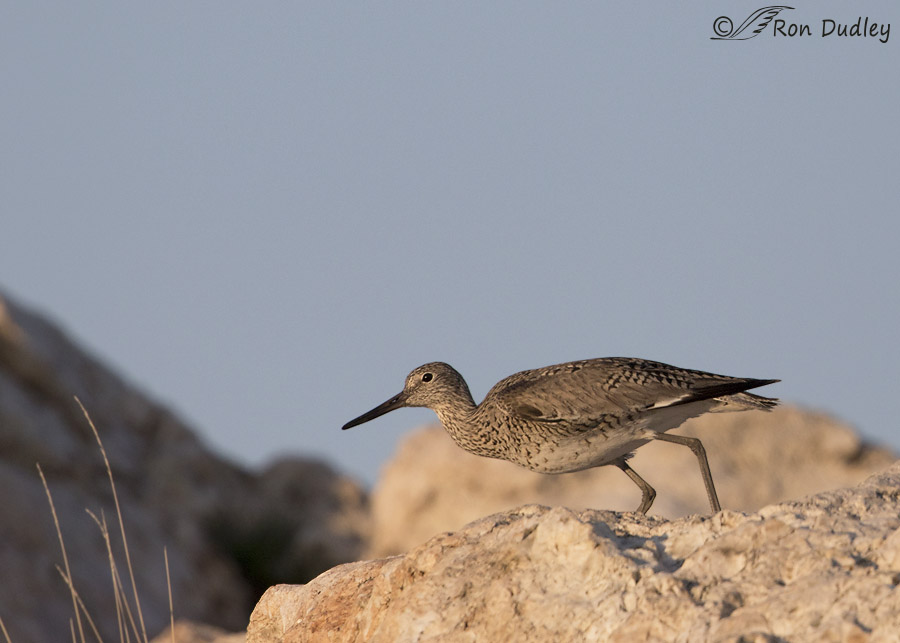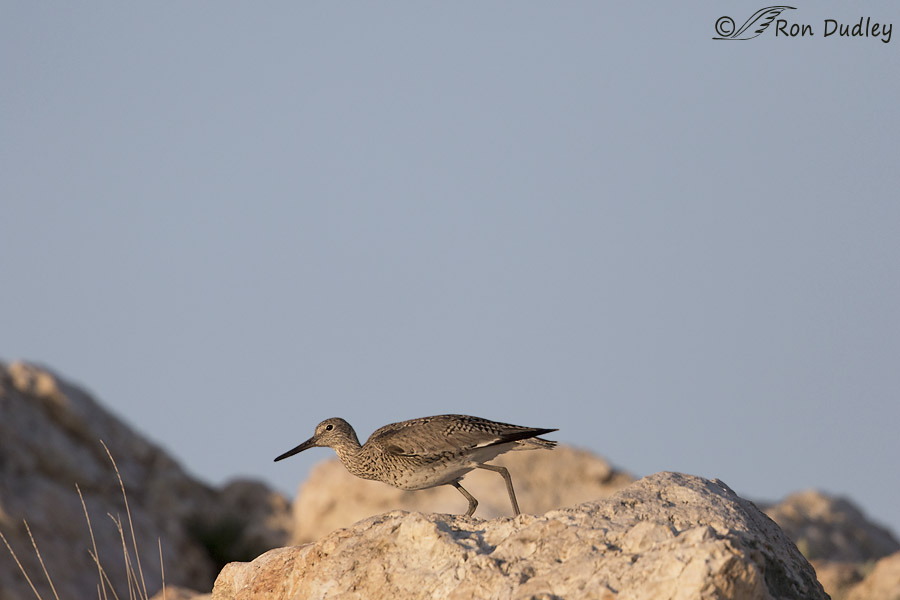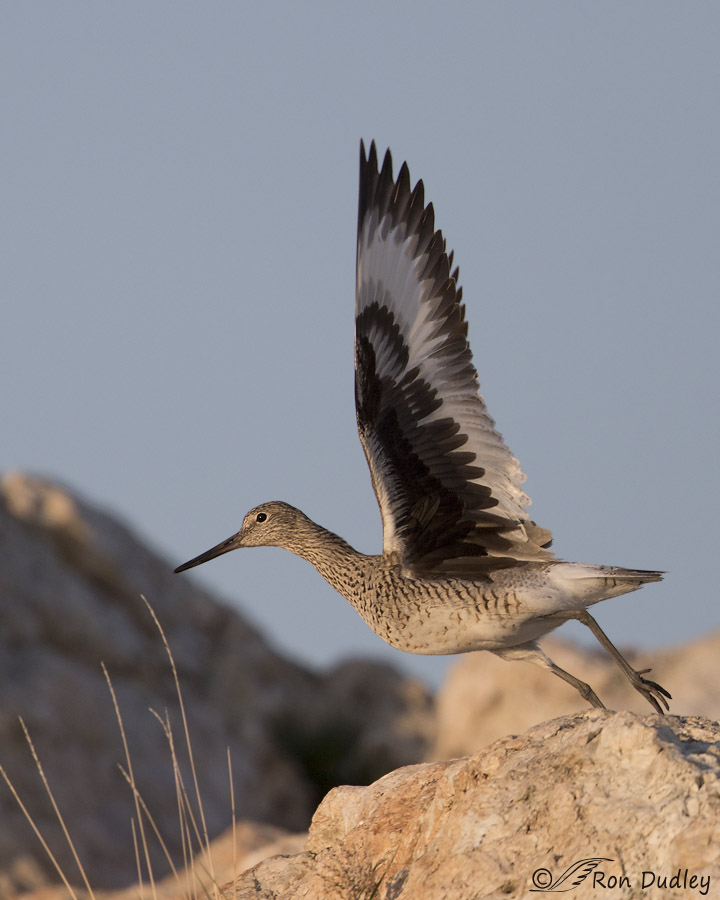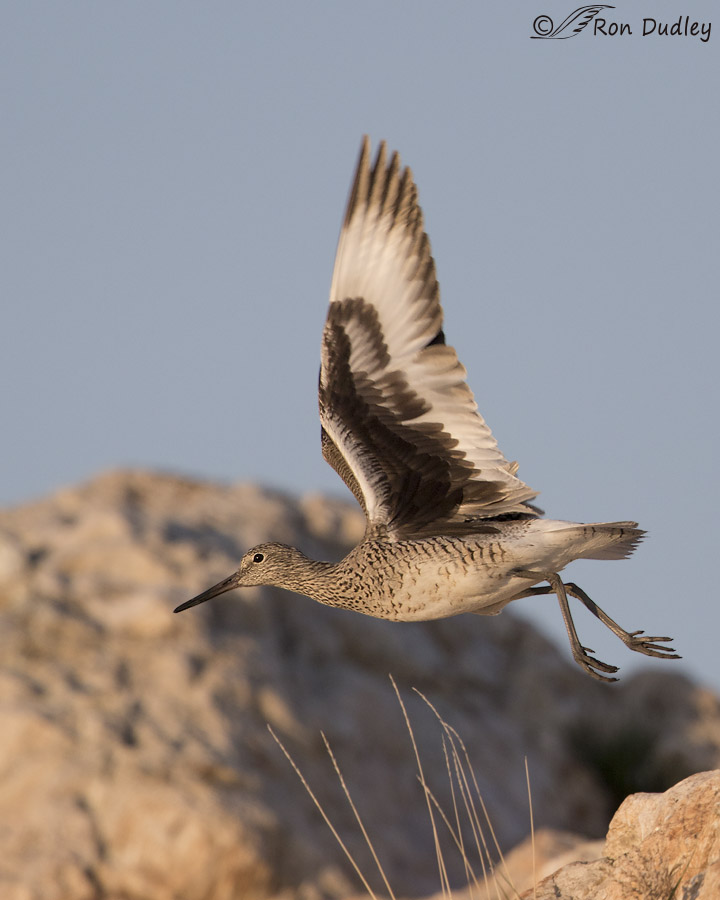Many things can go wrong when photographing birds at take-off and clipping wings is at or near the top of the list. The amount of room the photographer needs to allow for raised (or lowered) wings is hugely deceiving. Sure, you may catch the wings in a horizontal position without clipping them but that position is generally much less desirable.

1/2500, f/6.3, ISO 500, Canon 7D Mark II, Canon EF500mm f/4L IS II USM +1.4 tc, not baited, set up or called in
I photographed this Willet yesterday morning at sunrise on Antelope Island. The bird was above me on some very large rocks and it had its back to me most of the time while it was perched so I knew my best chance for getting any shots that I liked would be at possible take-off. Here the bird has crouched to do just that.
But this version of the image is deceiving because of the way it’s cropped. If this was all that I could see through my viewfinder I most certainly would have clipped its wings when the bird launched – there just isn’t enough room up top for the raised wings. Add two more variables to the equation, those long dangling legs and the fact that I don’t know at what angle the bird will take off (the elevated perch makes that even more of a guessing game) and the potential for clipped body parts becomes enormous.

But this full frame (uncropped) version of the same image demonstrates how I framed the Willet for take-off. I raised my lens just enough to allow plenty of room up top for the raised wings and still keep some of my active focus points on the bird. At first glance one may think that I’ve left far too much room up top for the wings but that’s not the case.

1/2500, f/6.3, ISO 500, Canon 7D Mark II, Canon EF500mm f/4L IS II USM +1.4 tc, not baited, set up or called in
This was the result. This version is within a few pixels of being full frame vertically so you can see that those wings take up a lot of space when raised.

1/2000, f/6.3, ISO 500, Canon 7D Mark II, Canon EF500mm f/4L IS II USM +1.4 tc, not baited, set up or called in
The next shot in the sequence is 100% full frame vertically with no pixels removed. I have just enough space for a pleasing composition above and below the bird with no body parts clipped or cut off. True, there are other issues with both images (mostly involving background) but I believe they make my point.
Photographing birds at take-off is nearly always a tradeoff between being close enough to get good detail and far enough away optically to avoid clipping body parts. It’s a fine balance and even if we do everything “right” there are no guarantees so the best the photographer can do is allow enough wiggle room for those raised wings and give ourselves the best chance possible for success.
Ron


Fantastic series Ron! Thanks for sharing!
Charlotte
Great shots, Ron. Unfortunately I am not doing so well with this exercise. I will keep practising.
Once again, Ellie Baby said it better than I could…backgrounds provide “a sense of place”…,thank you, Ellie Baby!
Compromise can be a sucky beast. Really sucky.
I am loving the background in these shots. A sense of place. And admiration at how well the honey colours of the wily Willet blend into its environment.
Thank you. Again.
Agree with Patty, EC – you nailed it with “sense of place”.
I’m chasing migrants right now so small birds (mostly warblers) and usually far away so quite small in the frame. I’m learning to predict flight plan occasionally, but it’s very difficult with these tiny guys!
Absolutely, Carol – take off direction of smaller birds is much more difficult to predict.
I really like seeing the backgrounds because I like to see “the whole picture” whenever possible, especially since I can no longer get to those places myself…those days are over and I miss them terribly! I guess the best of both worlds, is when you send a series…some images with background/context and some cropped,or tight, close ups. It’s a little like watching hockey…when it’s on TV, you miss so much, becuase it’s such a fast, “wide-angle” sport and between the “looking into a small box” aspect of TV, and the camerman’s zooming in, you can miss a lot of the interesting “visual outer fringe” elements…(yes, I know I’m speaking for myself here)… I also like seeing how the birds tend to blend with their particular backgrounds. Picking them out is not a problem for me. I enjoy it. I love the detail-rich close ups, too.
I wish you could still get out to “those places”, Patty. I really do! But since you can’t I’m glad you get some enjoyment out of my photos taken in them. Thanks very much.
Beautiful shots. I can see that the background is clear enough to detract from the bird if I let it, but seeing such beautiful captures of those wings makes up for that.
You’re right, Susan. No photograph is perfect and what we do is take the strengths and weaknesses together and see how they affect us overall.
I’m really falling in love with this little bird. Such a beauty!
I’m glad you’re enjoying the Willets, Arwen. Thanks.
An interesting series…from forward thrust position in anticipation of take off to what I call “fling”(push off) to fully raised wing positions…those wings are so long it would be easy to miss judge…amazing t,hst you capture them “whole” time after time….
“amazing that you capture them “whole” time after time….”
You (usually) don’t see the ones I clip, Patty and I do it a lot, even when I’m so cognizant of trying to avoid it. After photographing birds for as long as I have I STILL misjudge how much room is needed for raised wings too often.
Another useful lesson at least for me. And the second image is important because it shows where and how the action took place.
To be a bird photographer is not easy. A lot of challenging and unexpected situations… but what a thrill.
Thanks for sharing.
“And the second image is important because it shows where and how the action took place.”
Thanks for that feedback, Jorge. It helps to know when something I’ve included is helpful. Or not…
Nice series, as usual. Curious what active focus points you used and would that change for smaller birds?
Carol, I was using the central cluster of 5 focus points. Which ones I would use for smaller birds would depend on several things – including how large the bird was in the frame and if I thought I could predict the direction of take-off (it gets complicated to explain…).
Love the series, Ron!! Those wings are just beautiful & another bird I’ve never seen. Glad to meet ya, Mr. Willet!!
Happy to make the introduction, Jo Ann. Thanks
I always learn some technique or method of photographing birds from you and today is no exception! Great shots and teaching. Now I will go out and try what I learned today!
Thanks Ron
Thanks very much, Gary. I wish you luck today!